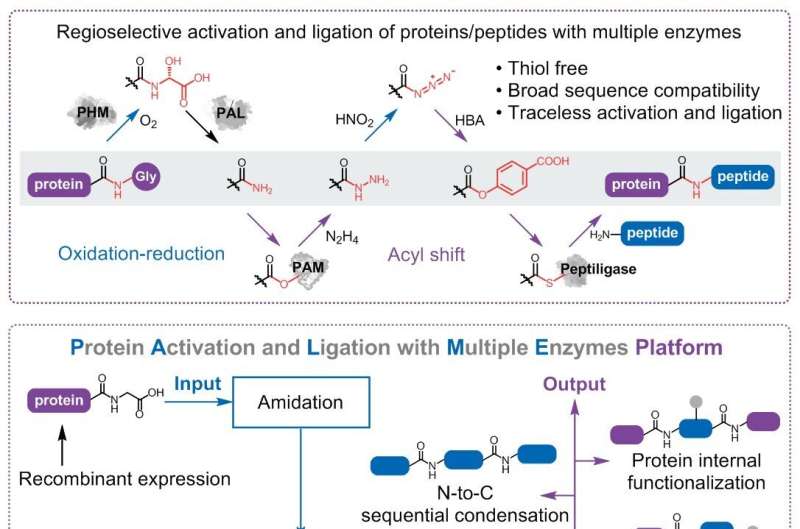Four biocatalysts work in series to realize the traceless conjugation of synthetic peptides and recombinant proteins, presenting broad application scope. Credit: Science China Press
A multi-enzyme platform is developed for sequence-unconstrained traceless protein synthesis and modification with either synthetic peptides or recombinant proteins, according to a new study out of Chinese Academy of Sciences and Fresenius Kabi.
The findings, published in the journal National Science Review, highlight that enzymes with diverse functions can be rationally harnessed to offer traceless protein synthesis and functionalization with remarkable flexibility in the choice of both ligation sites and peptide substrates.
Protein chemical synthesis and semisynthesis have profoundly impacted life science research as well as pharmaceutical innovation. For the past two decades, the development of protein synthesis strategies has been focused on how to perform the selective ligation of two unprotected peptides in the presence of the plentiful reactive side chains. Due to the specific molecular structure of the ligation site for chemoselective capture, the possible retrosynthetic disconnections of the existing chemical methods are limited to only a few amino acid residues.
"Nature brings forth sophisticated biomolecule systems for catalyzing a tremendous amount of reactions with excellent chemo-, regio- and stereoselectivity," said Dr. Bian Wu, a professor from Institute of Microbiology, Chinese Academy of Sciences. "We envisioned that the sequence-independent assembly of native peptides might be feasible by using multiple enzymes that present both strict regioselectivity and broad substrate specificity."
In the process of natural protein synthesis by the ribosome, the elegant collaboration of aminoacyl-tRNA synthetases (activation) and ribosome (ligation) has enabled the precise assembly of diverse amino acids without extra protecting groups. Similarly, to allow the conjugation of native peptides without side-chain protection, at least one enzyme for peptide C-terminal activation and an additional enzyme for amide-forming are required.
In this context, Wu and co-workers have been devoted to the mining and engineering enzymes related to peptide processing for over ten years. Remarkably, highly efficient and robust peptide amidase (PAM) for peptide C-terminal functionalization, and Peptiligase family for peptide conjugation, have been developed and demonstrated to be applicable in industrial pharmaceutic peptide manufacture.
In the present study, a bridge joining the two biocatalysts is introduced to construct the complete reaction route. The peptide amide, one of the most basic solid-phase peptide synthesis (SPPS) products, is initially modified by PAM to produce the corresponding peptide hydrazide. Afterward, the peptide hydrazide is oxidized and transformed into the peptide ester, which is subsequently utilized as the substrate of Peptiligase for traceless ligation.
This cascade reaction route is also available for recombinant proteins with the assistance of peptidyl-glycine hydroxylating monooxygenase (PHM) and peptidyl-α-hydroxyglycine amidating lyase (PAL) that can produce the des-glycine peptide amide. The versatility of each enzyme was evaluated via nearly two hundred model reactions in total, demonstrating the splendid sequence compatibility of this protein activation and ligation with multiple enzymes (PALME) platform.
To further examine the application scope of the PALME platform, Wu and co-workers synthesized a group of real-case targets ranging from active pharmaceutical ingredients to functional modified proteins, including several currently intractable targets like an internally functionalized biomacromolecule and a recombinant protein bearing multiple adjacent Cys residues.
Owing to the modular nature, the PALME platform is also highly complementary to other modern techniques like flow chemistry for constructing cooperative protein synthesis procedures. "We anticipate that this study will serve as a blueprint for the future development of a widely applicable protocol to access synthetic proteins, and facilitate the development of synthetic biology.", said Wu.
More information: Ruifeng Li et al, Traceless enzymatic protein synthesis without ligation sites constraint, National Science Review (2021). DOI: 10.1093/nsr/nwab158
Provided by Science China Press
























